A
Whole Lotta Crankin’ Going
On, Part 2 – Flat Sided Crankbaits
The Little Guys
By Chip
Pillow, Lucky Craft Regional Pro Staff
With Contributions from Skeet Reese
Over the last couple of articles I've written, I've had
the pleasure of introducing you to some of the best crankbait fishermen
I know. Readers have gotten to dip into the minds of crankbait
gurus like FLW Tour Pro and Lake Fork guide Tom Redington, BASS Open
angler and Humminbird Side Imaging extraordinaire Doug Vahrenberg,
and Lake Altoona guide and lure designer Mike Bucca. Even as
one who considers himself a crankbait freak, I have learned a lot from
this crew. Oh but the fun doesn't end there.
In this article I want to continue to expand on the Lucky Craft line
of crankbaits by introducing what I call the "Flat Series" of
baits. While Lucky Craft has a number of flat sided crankbaits,
I am going to be focusing on the Flat Mini and SKT series of crankbaits
in this article. As I've stated in previous articles, Lucky
Craft creates specific baits for specific purposes. The flat
sided baits are no different. They are tools to help an angler
catch more fish. When these tools are understood and applied
in the right situation, they are deadly. I mean deadly! So
I started thinking... "In addition to the cast of characters
that have added so much insight into the Lucky Craft line of crankbaits,
who else could I get to offer some input?" How about jacking
up a half-court shot and seeing if I can get the number one ranked
angler in the world? After all he designed a whole line of these
baits. Well I got him. So hold on to your seats because
I have a wealth of information to share from these guys.
SKT Mini The
SKT Mini was the first bait in the SKT line. The bait comes
in a medium runner (MR, 2", 1/4 oz, and dives to around
4-5 feet) and the deep runner (DR, 2", 3/8 oz, 6-7ft). Skeet
explained that he designed the Mini for clear water applications on
highly pressured bodies of water where catching a limit of keeper fish
is of utmost importance. The diminutive sized bait allows the
angler to cover the water of a power fisherman, while simultaneously
engaging a "finesse" style that is needed when fish that
see a lot of baits. It is in this type of situation that the
SKT Mini excels.
First of all, the Mini does not have
rattles. Most crankbait anglers start to get a little nervous when
they consider a crankbait without rattles. We are conditioned to think that if it's
a crankbait, it has to rattle. Well that's all well and
good when fish are aggressively eating. But remember, the Mini
was designed for bass that get a ton of fishing pressure. So
when Skeet chose not to include rattles, he provided a bait that can
move through the water and give pressured bass a very different presentation
then they are used to.
Now just because the Mini is not equipped with rattles doesn't
mean it doesn't have fish calling capabilities. The shape
of the crankbait, specifically the flat sides, is designed to create
a water disturbance which is picked up through a bass' lateral
line. The key is that it's a very subtle type of water
movement. So the Mini provides a very unique action; that being
it has a very tight wiggle, while also creating a fair amount of water
displacement. In my opinion, this is a major factor that makes
the SKT line so deadly.
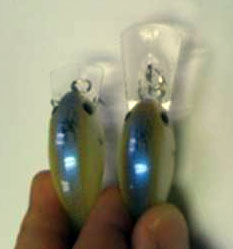 The shape of the bill on the front
of the Mini provides three very important aspects in finesse crankbait
fishing. Take a look at the picture (the MR is on the left and DR on
the right). First of all, notice the bill is nearly square. This unique
shape gives the bait a very tight wiggle. Highly pressure fish have
seen so many crankbaits wallowing through the water (with rattles)
that they become very conditioned to the action, sound, and water displacement
of a busy bait. A tight wiggle is a much more natural looking
movement. So the tight wiggle of the Mini is another feature
that gives it an entirely different look, while also suggesting an
easy meal.
The shape of the bill on the front
of the Mini provides three very important aspects in finesse crankbait
fishing. Take a look at the picture (the MR is on the left and DR on
the right). First of all, notice the bill is nearly square. This unique
shape gives the bait a very tight wiggle. Highly pressure fish have
seen so many crankbaits wallowing through the water (with rattles)
that they become very conditioned to the action, sound, and water displacement
of a busy bait. A tight wiggle is a much more natural looking
movement. So the tight wiggle of the Mini is another feature
that gives it an entirely different look, while also suggesting an
easy meal.
Now we all tend to think that baits
with tight wiggles are primarily "cold
water" baits. Skeet told me this is definitely not true. Not
at all! The square bill, tight wiggle, and flat sides are designed
to move water and not alarm fish, even in warm water. Even in
summertime warm water. So while the tight wiggle makes the Mini
an excellent cold water bait, it's certainly not limited to times
when the mercury dips. For example, I have had a tremendous
amount of success during the summer months burning the Mini on the
outside edge of lily pads when bass are seeking cover from the hot
sun.
The second important aspect of the
bill's shape is that it goes
through cover very well. The squared bill gives the Mini the
benefit of deftly working through hard cover, such as scattered stumps,
rip-rap, and chunk rock without getting hung. Lucky Craft Pro
Doug Vahrenberg used the SKT Mini as one of his main weapons during
the recent BASS Open tournament at Lake Texoma. Doug told me, "I
was cranking big boulders near main river channel swings. On Texoma
there is not a lot of other cover and rocks were the key. The SKT Mini
DR bill design allows it to hunt around the boulders versus up and
over...it was a huge key in finding and catching fish. It's something
that is very unique to the Lucky Craft 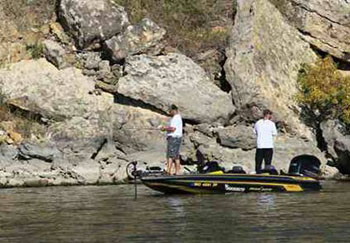 crankbaits and especially the
SKT Series; the baits are designed to hunt around cover versus banging
into them and flipping up and over. The hunting action drives fish
crazy and makes them react. A reaction bite is easier to get fish to
bite than feeding because of hunger. If someone was running around
in your house you didn't know...wouldn't you react to them???" This
picture is an example of the terrain that Doug was fishing. Take
a look at that gnarly looking bank. What you see above the waterline
was the same thing the SKT Mini was working through beneath the water. Now
that's what I call "deflectability"!
crankbaits and especially the
SKT Series; the baits are designed to hunt around cover versus banging
into them and flipping up and over. The hunting action drives fish
crazy and makes them react. A reaction bite is easier to get fish to
bite than feeding because of hunger. If someone was running around
in your house you didn't know...wouldn't you react to them???" This
picture is an example of the terrain that Doug was fishing. Take
a look at that gnarly looking bank. What you see above the waterline
was the same thing the SKT Mini was working through beneath the water. Now
that's what I call "deflectability"!
However, I believe the cover where this baits excels the most is in
grass. In my opinion, this is the best grass crankbaits on the
market. When fished on braided line, the bill will cut through,
or slide off grass much easier than other crankbaits. I fish
the TVA lakes. There are two constants on these lakes: grass
and a lot of anglers. When bass on the TVA lakes have seen every
form of lipless bait, frog, and jig known to man, the Mini is an excellent
choice to fish the grass. Fishing the Mini along the outside
edge of scattered grass has saved my day many times.
The third aspect of this bait that
allows it to excel on pressured fish is the perfect tracking the bait
possesses. What this means
is that the Mini can be reeled at incredibly high speeds and run "true" throughout
the length of the cast. This is especially important in the Fall
of the year. Bass that get a lot of fishing pressure often need
to be "coaxed" into biting. Even though they have
seen a lot of baits, a reaction strike is still one of the most effective
means to get pressured fish to commit. Skeet told me, "Speed
triggers strikes and you can't out-reel a fish. So while
you might think you are reeling it really fast. To a fish, it's
not moving too fast." With the Mini's ability to
track true the bait is subtly and quickly in their face before they
can become alarmed. Then mother-nature just takes over.
FLW Tour pro Tom Redington pointed
out another unique characteristic of the Mini that gives it a huge
advantage on clear water lakes. Tom
noted that the Mini will get down 1-2 feet deeper than most other square
bill cranks. "This is often a big plus in clear water
because bass are holding a little deeper than in murkier water. (They)... will
get down and bump rocks or the tops of weeds that other guys can't
touch with their square bills."
Now
please don't think that because the Mini is a small bait it only
catches small fish. Yes it was designed to put limit fish in
the boat. Yet there
are also big fish that live in highly pressured lakes. These fish got
big for a reason. They too have seen the same plethora of crankbaits
that the smaller fish have seen. Yet they also need to eat. So
in these situations, the Mini is also an excellent choice for kicker fish. For
instance, Lake Fork is one of the most heavily pressure lakes in the country.
It is also a noted big fish lake. Tom Redington said he loves the Mini
on his home lake because he can use the bait on 15-17 pound line and not worry
about the heavy line impacting the action. Additionally, Skeet told me
that one day while he was fun fishing in one of the most heavily pressured
areas of the California Delta he busted some huge fish. While casting
the Mini on an outside edge of tules he boated an 8 pounder and two 7's.
So the bait was designed to put limit fish in the boat. However, Swamp
Donkeys will also eat the bait.
Ok, let
me take a quick side-step. In these articles I have not really gotten
into color choices. For one, talking about color in lure selection
to anglers is about the same as bringing up politics or religion at
a social gathering. Meaning,
everyone has an opinion on it and typically all it does is start an
argument. Secondly,
if these guys do suggest a color they like for certain applications,
there ain't no way I'm going to print it and give away
that kind of helpful information. I have to fish against a lot of you
jokers, and I want all the advantages I can get. Well, it's
Christmas and I'm feeling
somewhat generous. So I guess I will share some of the color
information I was given.
This color information is courtesy
of FLW pro Tom Redington. Tom
said that the SKT Mini MR in Chartreuse Rootbeer is one of the little
known "go to" baits for some of the top anglers around
the Dallas area. Redington stated that Chartreuse Rootbeer is
one of those special colors that has worked for him in all water colors
and lakes all around the country. The new Magic Craw color is
a great alternative to the traditional Wiggle Wart for highland lakes
like Table Rock and Beaver Lake. In clear water when bass are
chasing shad or bluegill, Tom likes the translucent colors like Ghost
Chartreuse Shad, Light Hitch, and Ghost Baby Bluegill. The new
Delta Craw is great for muddy water on bright sunny days. Ok,
there you go. Color. I might regret this later.
SKT There
has been very few baits that I have eagerly anticipated their arrival
to the market. Sure
I spend way too much money on lures. But as far as really looking
forward to the introduction of a new lure, I usually don't get
all that jacked up. Since I have loved the SKT Mini, I was looking
forward to the release of the SKT. Like the Mini, the SKT comes
in a medium runner (MR, 2 1/2", 3/8oz, 6ft) and a deep runner
(DR, 2 1/2", 3/8oz, 10ft). While the Mini and the
SKT resemble each other, the SKT is not just a bigger version of the
Mini. Like the Mini, the SKT has no rattles, possesses a very
tight wiggle, and tracks true at high speeds. The SKT was also
designed for fishing highly pressured lakes. However, there are
some differences that make the SKT a needed addition for any serious
angler's box.
The first
is the size of the bait. The SKT is 1/2 inch longer, possess
more girth than the Mini, and brings a longer bill to the party. One
obvious advantage to the angler is that the SKT is able to achieve
a greater diving depth. The SKT MR will dive to 6 feet, and the
DR will reach a depth of 10 feet. As Tom Redington noted earlier,
this is important when pressured fish are seeking slightly deeper water
and other square bill crankbaits won't
touch that depth. Another advantage is that the size upgrade
allows the angler to more effectively "match the hatch" when
bass are feeding on larger bait. The closer an angler can imitate
the exact size of the bass' food source, the better the chances
of success. This is especially
necessary on highly pressured water.
Another
size advantage that the SKT has is one that's rather counterintuitive.
It's
bigger than the Mini, yet it's still a relatively small crankbait.
So maybe think in terms of the SKT being bigger, but not too big. In
talking with Skeet Reese, he believes that most crankbaits are over-sized. "We
typically think of big baits for big bites. Often that is just
not true... especially when fish are pressured." So the SKT provides a size upgrade.
Yet it is still small enough for finesse cranking pressured fish.
Another
advantage of the increased size is the SKT's ability to be fished
in more colored water. While the Mini was designed for clear
water situations, the bigger SKT can be fished in stained water. So
for anglers who fish highly pressured lakes that are not gin clear,
the SKT might be a better fit because bass in stained water don't
get as clear of a look at the bait as those fish in clear water. So
the SKT offers a bigger profile that is more visible in off colored
water. Take Lake Guntersville for instance. Tom
Redington told me he was fishing an FLW Tour tournament on Guntersville
during the spring. Typical of Guntersville in the spring the
bass on the flats were getting hammered with lipless crankbaits, and
they stopped biting. Tom
was able to go right behind other anglers and catch fish on the SKT
MR (Ghost Chartreuse Shad).
Additionally
the SKT, like the Mini, is a flat sided crankbait that is designed to create
enough water disturbance to indicate the presence of a food source, while not
being so busy as to alarm the fish that another bogus piece of plastic is rattling
toward them. So, the size of the SKT allows the angler all the great
benefits that are absolutely necessary for finesse cranking, while also providing
the angler a bait with a larger profile that can be fished in a wider band
of water color and at greater depths.
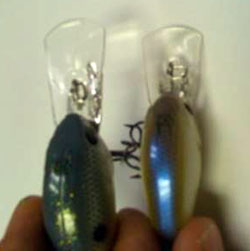 Another
ever so slight, yet very important, difference to note with the SKT
is the angle of decline in the bill. There is certainly a difference
in length, which allows the SKT to dive deeper. While this is a great
advantage when fish move deeper, that's not what I'm talking about
here. Ok, confession time. I must warn you... here's one of the inherent
dangers of becoming obsessive about crankbaits. Not only do you feel
compelled to spendexorbitant amounts of money on them, you also start
to notice very slight variations that make baits perform different.
However, many times these slight differences are what can turn a slow
day good or a good day great. If you are not into such detail, please
feel free to skip to the next section. For those of you who are left,
take a look at the picture.The
SKT DR is on the left and the Mini DR is on the right. Notice the slight
difference in the decrease in angle from the tip/end of the bill to
where it intersects with the body in the SKT. Specifically, the end
of the bill on the SKT joins the body right in front of the bait's
eye, whereas the end of the bill on the Mini joins the body at the
center of the bait's eye. While this might seem like straining a gnat's
butt to some, the difference creates a slightly different wobble. Don't
get me wrong. The SKT still has a very tight wiggle. This is just another
detail that allows the SKT to move a smidge more water, while retaining
the same tight wiggle that is synonymous with Skeet's signature series.
Here's
another way to think about it. An autumn day when the air temperature
is 30 degrees and the humidity is 50% is fairly cold. Similarly,
an autumn day when the air temperature 30 degrees and the humidity
is 95% is still cold. It's just a different feel of cold. Such
is the tight wiggle of the SKT. It's tight; it's
just a slightly different version of tight.
Another
ever so slight, yet very important, difference to note with the SKT
is the angle of decline in the bill. There is certainly a difference
in length, which allows the SKT to dive deeper. While this is a great
advantage when fish move deeper, that's not what I'm talking about
here. Ok, confession time. I must warn you... here's one of the inherent
dangers of becoming obsessive about crankbaits. Not only do you feel
compelled to spendexorbitant amounts of money on them, you also start
to notice very slight variations that make baits perform different.
However, many times these slight differences are what can turn a slow
day good or a good day great. If you are not into such detail, please
feel free to skip to the next section. For those of you who are left,
take a look at the picture.The
SKT DR is on the left and the Mini DR is on the right. Notice the slight
difference in the decrease in angle from the tip/end of the bill to
where it intersects with the body in the SKT. Specifically, the end
of the bill on the SKT joins the body right in front of the bait's
eye, whereas the end of the bill on the Mini joins the body at the
center of the bait's eye. While this might seem like straining a gnat's
butt to some, the difference creates a slightly different wobble. Don't
get me wrong. The SKT still has a very tight wiggle. This is just another
detail that allows the SKT to move a smidge more water, while retaining
the same tight wiggle that is synonymous with Skeet's signature series.
Here's
another way to think about it. An autumn day when the air temperature
is 30 degrees and the humidity is 50% is fairly cold. Similarly,
an autumn day when the air temperature 30 degrees and the humidity
is 95% is still cold. It's just a different feel of cold. Such
is the tight wiggle of the SKT. It's tight; it's
just a slightly different version of tight.
Flat Mini The
Flat Mini should be a staple in any serious crankbait anglers
arsenal. While the bait resembles the SKT Mini, it's an
entirely different bait. Understanding the differences give
the angler a deadly one-two punch when the Flat Mini is combined with
the SKT Mini.
For starters,
the Flat Mini comes in a variety of offerings to cover a variety
of depths. There
is the SR (2", 1/4oz, 1ft), the MR (2", 5/16oz, 3ft) and the DR
(2", 3/8oz, 6 ft). Lucky Craft has also introduced three new baits
to this line in the D-6 (2", 5/16oz, 6ft), the D-8 (2", 3/8oz,
8ft) and the Mini SS (2", 5/16oz, slow sinking). While these new
additions bear the same basic body style, the bill is quite different than
the SR, MR, and DR.
One of the differences between
the Flat Mini and the SKT Mini is that the former has rattles.
The Flat Mini achieves its rattle through the use of Lucky
Craft's weight transfer system. What this
means is during the cast a tungsten ball moves to the tail
of the bait. With
the ball in the tail, the bait casts a mile because it has
less chance of "helicoptering" during the cast. Once
the bait hits the water and the angler begins the retrieve,
the ball moves to a cavity located at the front of the bait.
This movement, or transfer, accounts for a steep dive and allows
the Flat Mini to get to its running depth very quick. Once
the diving depth is reached, the bait planes off and the wiggle
of the crankbait causes the tungsten ball to move back and
forth inside the front cavity. This sound
resembles the natural "ticking" noise often used
by fleeing baitfish and crawfish.
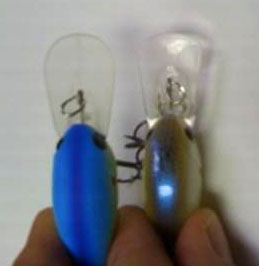 Another aspect of the Flat
Mini that differentiates it from the SKT Mini is the shape
of the bill. Check out the picture (the Flat Mini DR is on
the left and the SKT Mini Dr the right): Notice
how the Flat Mini DR has a more rounded bill as compared to
the SKT Mini DR's bill being relatively square. The
action of the Flat Mini is more pronounced and has a wider
wobble. While the
Flat Mini still has a relatively tight wiggle, it is wider
than that of the SKT Mini. To get a first hand visual
on the action of the bait, please see the video on the Lucky
Craft website.
The importance of the two distinct type of wiggles is that
the angler can match the mood of the fish. Say, for instance,
you are fishing down an outside grassline. I will typically
alternate the Flat Mini and the SKT Mini until the fish tell
me which one they prefer. Another practical application where
both baits are needed is when the fish are active and really
eating the Flat Mini, but then seem to shut down. I
will then pick up the SKT Mini and go back through the same
area, but with the advantage of a silent bait. This switch
will often produce several more fish from the same area.
Another aspect of the Flat
Mini that differentiates it from the SKT Mini is the shape
of the bill. Check out the picture (the Flat Mini DR is on
the left and the SKT Mini Dr the right): Notice
how the Flat Mini DR has a more rounded bill as compared to
the SKT Mini DR's bill being relatively square. The
action of the Flat Mini is more pronounced and has a wider
wobble. While the
Flat Mini still has a relatively tight wiggle, it is wider
than that of the SKT Mini. To get a first hand visual
on the action of the bait, please see the video on the Lucky
Craft website.
The importance of the two distinct type of wiggles is that
the angler can match the mood of the fish. Say, for instance,
you are fishing down an outside grassline. I will typically
alternate the Flat Mini and the SKT Mini until the fish tell
me which one they prefer. Another practical application where
both baits are needed is when the fish are active and really
eating the Flat Mini, but then seem to shut down. I
will then pick up the SKT Mini and go back through the same
area, but with the advantage of a silent bait. This switch
will often produce several more fish from the same area.
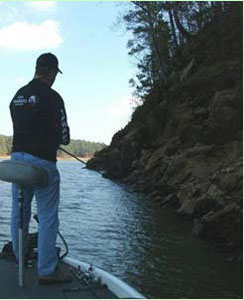 One
of my favorite applications for the Flat Mini comes courtesy
of my friend Mike Bucca. The
Lake Altoona guide loves to fish the Flat Mini when fish are
on bluff walls. Mike
will parallel the bluff wall in order to maximize the time
the bait is in the strike zone. If you position your
boat away from the wall, the bait is only in the strike zone
for a brief time. Keeping the bait in this strike
zone is especially important during the winter months when
fish move up to the shallow rocks seeking heat. As seen
in the picture, Mike will position his boat right next to the
bluff wall and try to make the Mini ricochet off of rocks,
stumps, or anything that might be holding heat, and thus fish.
Another valuable piece of information Mike gave away is that
he will fish the Flat Mini on bluffs that have a 45 degree
angle. If the bluff is steeper than 45 degrees, Mike will switch
to the Flat CB DR.
One
of my favorite applications for the Flat Mini comes courtesy
of my friend Mike Bucca. The
Lake Altoona guide loves to fish the Flat Mini when fish are
on bluff walls. Mike
will parallel the bluff wall in order to maximize the time
the bait is in the strike zone. If you position your
boat away from the wall, the bait is only in the strike zone
for a brief time. Keeping the bait in this strike
zone is especially important during the winter months when
fish move up to the shallow rocks seeking heat. As seen
in the picture, Mike will position his boat right next to the
bluff wall and try to make the Mini ricochet off of rocks,
stumps, or anything that might be holding heat, and thus fish.
Another valuable piece of information Mike gave away is that
he will fish the Flat Mini on bluffs that have a 45 degree
angle. If the bluff is steeper than 45 degrees, Mike will switch
to the Flat CB DR.
So there
you have it. Volume 2 of the Lucky Craft crankbait series. I
hope this article has helped the reader understand the differences
between the SKT series and Flat Mini series of Lucky Craft
baits. I have
found that understanding these differences and combining the
two baits provide an excellent one-two punch for putting fish
in the boat.
I
also want to take this time to thank the guys that contributed
to this article. Their
input has been invaluable. Please check them out on the
web for more tips and info on Lucky Craft baits.
Skeet Reese: www.skeetreeseinc.com
Tom Redington: www.lakeforkguidetrips.com
Doug Vahrenberg : www.dougvahrenberg.com
Mike Bucca: www.tritonmike.com and
also http://www.tritonmike.com/bullshad.html
Good Luck and Good Fishing,
Chip

